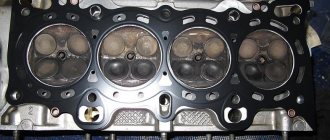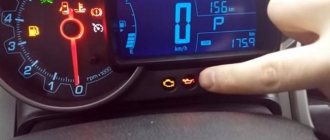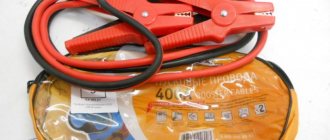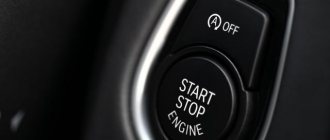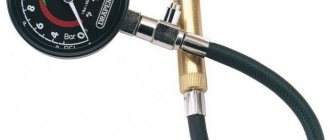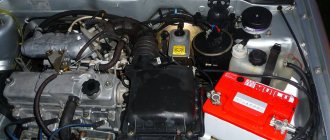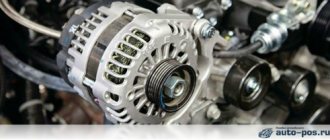Many car owners wash their car engine themselves. Of course, it is necessary to clean it, because its performance and durability depend on how clean it is. However, sometimes after such a procedure the power unit presents motorists with trouble - it starts to misfire or the car refuses to start. In order to react in a timely manner to such a turn, every driver must know what to do and how to proceed.
Let's first understand the concept of “engine troit”. Troubleshooting is an engine malfunction in which any of the 4 cylinders stops working. The cause of such a breakdown may be vibration due to the large amplitude of operation of the car engine. A power unit with a faulty cylinder will work intermittently.
Sometimes when driving with a dead cylinder, the car jerks noticeably and fuel consumption increases. The power also drops, and difficulties arise in starting the unit, especially after a winter wash.
The engine may malfunction after a car wash for the following reasons:
1. Liquid may get into the spark plug wells. Due to water, the spark plug does not produce a spark, and the cylinder, of course, does not function.
2. Problems with the motor can also arise due to sensor failure if car shampoo gets into them.
3. Washing equipment is often used to supply water under high pressure. Such cleaning of the unit can lead to failure of easily vulnerable parts. Therefore, automakers do not recommend washing the engine under high pressure.
When summarizing the causes of breakdowns of an engine that has undergone cleaning, it all comes down to the ingress of liquid into those parts of the unit that can only operate normally when dry.
How to fix the situation
Since the cause of malfunctions after a car wash is water, everything possible should be done to remove it.
To do this, you need to park the car in a dry place and wipe all electrical wiring dry. The same should be done with the armored wires of the spark plugs. Then it is important to check the battery terminals and make sure that everything is in order with them.
The contact can be worsened by a gray coating formed on the terminals. It can be removed with water. The washed terminals must be wiped dry and tightened properly.
But if the liquid did not get under the hood during the washing process, then the measures described above will be enough to bring the engine into working condition.
If water has penetrated into the engine compartment, then a lot of effort will have to be made to put the power unit in order.
Putting things in order under the hood
First of all, you should check the operation of the ignition system, since this is where problems most often arise after washing.
In cars equipped with an ignition distributor, you need to disassemble the distributor and then remove any remaining water from under the cover. After everything is well wiped, you need to wipe the armor wires dry. We should not forget about candle windows - it is important that they are dry.
Since we are already talking about blowing out spark plug windows, it makes sense to note: many drivers, with flooded spark plugs, try to start the car engine with choke. But this is not very effective. When purging the spark plugs, you need to remove the choke, squeeze out the gas and start the engine. This way you can carry out high-quality cleaning and start the car.
If the vehicle has a distributorless ignition, and each cylinder has an individual coil, then the motorist will have to remove all the coils, blow out and wipe the spark plug wells dry. In this situation, there is both a plus and a minus: it is more difficult to remove the cover from the distributor than the coils, but it will also be difficult to reach some coils.
To make sure that the spark plugs are in working order, they will have to be unscrewed and checked.
After completing all the necessary procedures, you can try to start the car.
To prevent the car from jerking, the distributor must be cleaned, and the high-voltage wires and ignition coils must be properly lubricated. This can be done with WD-40. This will allow you to maintain the functionality of the unit after washing.
Another cause of frequent problems with a vehicle’s power unit can be a crack in the distributor housing or a breakdown of armored wires. The power unit can also malfunction after washing the car body. This situation is very easy to fix - you need to find the cracked part and replace it with a new one.
From time to time, motorists have to deal with various problems in the operation of the unit. Their cause is often not engine washing. And since some malfunctions occur quite often, it will be useful for drivers to know about them.
Sometimes drivers, underestimating a specific section of the roadway, climb into a deep puddle in which the engine stalls. If this happens, it means only one thing: liquid got under the distributor cover and flooded the coil and wires. In this case, you will have to find a clean cloth and wipe the motor dry.
The next unpleasant moment that motorists have to deal with is suddenly a car. If an engine with a timing belt is installed in it, then, most likely, its breakage is to blame. A sign of his impulse will be a rapidly spinning starter.
But if the belt is intact, then you should check the fuel pump and make sure that it is working normally, check the ignition spark and the carburetor.
Electronic ignition can also cause problems. If this is the problem, the engine will stall and even stall.
Car wash was only outside
After washing the body, a small amount of liquid may accumulate in the engine compartment that needs to be removed. This can be done using a piece of absorbent cloth or a compressor (carefully dry the entire space with a stream of air).
Attention should be paid not to the entire volume of space, but only to the electrical wiring and armored wires of the spark plugs. You should check the reliability of the contact of the terminals on the battery. Sometimes a specific coating forms on them, which appears as a result of the chemical interaction of lead and copper. It can be watered with a small amount of tap water and cleaned with sandpaper or a brush with hard bristles. Then you will have to tighten the terminals, since after removing the plaque a small gap will form.
After the above steps, the car should start.
Moisture in the engine - what to do
Since the car is not able to operate correctly due to moisture ingress, all measures must be taken to eliminate it.
To do this, park the car in a dry, warm place, then wipe off any water from the engine compartment with dry rags. The same procedure must be done with the armored wires of the spark plugs. Next, you should check the terminals in the battery - you need to make sure that they are in perfect order. If you notice that they have turned gray, this indicates severe oxidation. Use fine-grained sandpaper and gradually remove the layer of oxidized metal. Naturally, all this must be done in a de-energized car so that you do not get an electric shock.
Procedure after washing the engine compartment
If general cleaning concerns the engine compartment and all its contents, then all components must be thoroughly dried with a cloth.
First, you should pay attention to the ignition system: if it is equipped with a distributor, then it will have to be disassembled and dried. Then wipe the armored wires and dry the spark plug wells.
If there is no distributor, then all the coils are removed and wiped individually, and then the spark plug wells or car wires are dried.
This small set of works is recommended to be carried out immediately after washing the car, that is, before the very first start.
Afterword
If the car consistently does not want to work after washing, then the reasons may be small cracks in the distributor cover or in the insulation of armored wires, or insufficient engine tightness. In any case, the fault must be found and eliminated.
On the other hand, such complications are easy to avoid: you should not wash the engine under high pressure; it will be enough to rinse it under a running hose or douse it with a bucket of water. To wash the engine from dirt, you need to purchase high-quality chemicals and begin the procedure or go to a car wash, which can be found on specialized websites, for example, GoBonus.
What to do if the car does not start after washing the engine?
Hello, dear guests and readers of the automotive blog. In this article we will look at what to do if the car engine does not start after washing. Car owners often face this problem. Many people do not know how to look for the causes of a malfunction after washing. The car will not start if the washing was carried out incorrectly or in gross violation of the established rules.
If after washing the car refuses to start, there is no need to panic and take it to a service center. Almost always, the consequences of improper washing are eliminated independently without outside help. Often, not only the body is washed, many owners ask to wash the engine.
The problem with starting the engine is that water gets into individual components. They function fully when dry and the ingress of water can lead to failure or serious malfunction. At the end of the article you can watch a video on how to properly wash a car engine. It will help you avoid common mistakes.
This is interesting: Bad driving habits that can cost you a pretty penny
What to do if the car does not start after a regular wash?
The inappropriate efforts of washers lead to a large amount of water getting into the engine compartment of the car. They are guided by good intentions, but it turns out as always. We wanted it to be better, but it turned out the other way around.
This often happens when using a special Kärcher washing machine. Capable of supplying water under high pressure. A powerful jet of water will easily find its way under the hood of the car and flood all possible niches.
The procedure for “reviving” the car after a regular wash is as follows:
1. The hood of the vehicle is opened and carefully inspected for any accumulation of water on or near the engine.
2. Moisture is removed from the battery terminals, armored spark plug wires and other wiring.
3. Frequent car washing leads to the accumulation of excess moisture under the hood of the car. High humidity causes the formation of gray deposits on the battery terminals. It needs to be removed. The contact between the terminals and the battery deteriorates. All this is a common reason for difficulty starting the engine.
4.Water accumulations in the engine compartment are removed with rags and a sponge. The sponge is convenient because it can absorb more water in hard-to-reach places. Using a rag will not completely remove the water.
5.After removing the water, the engine and problem areas (spark plugs, battery, electrical wiring) are dried. Next, you can try to start the car. If the reason was water, it will start without problems and the engine will run smoothly.
When starting problems occur again, the problem is not with the car wash. Just a coincidence, the problem lies elsewhere.
Why doesn't the car start yet?
In addition to the main reasons why the engine refuses to start, there are a number of factors that the driver needs to be aware of:
- The anti-theft system, which blocks the fuel supply, is not disabled.
- Flywheel wear.
- When turning the key, the starter does not engage with the ring teeth, and a characteristic grinding noise is heard.
- Malfunction of the generator, breakdown of the air conditioning compressor, power steering pump. Timing belt stretched or broken.
If a breakdown of the timing chain or belt occurs while the car is moving, it is necessary to prepare for an engine overhaul, since the pistons will be bent. If the starter turns without effort when starting the engine, you can get by by replacing the belt. A similar situation occurs if the timing drive has slipped and disrupted the order of the valve timing.
Malfunction of the crankshaft: scuffing that leads to high resistance of the part, wear of bearing shells, etc. We check the performance of the crankshaft as follows: if the engine can be cranked while pushing in a high gear with a manual transmission, the crankshaft and adjacent units are in order. There are plenty of reasons why a car won’t start, but the lion’s share consists of starter malfunctions, a discharged battery, and malfunctions of the high-voltage wires. By systematically checking the units, you can protect yourself 99% from such a problem.
Before the maintenance, I decided to wash the engine. I wasn’t particularly afraid, because... friends washed it and nothing. We finished washing (with a Karcher) and waited about forty minutes. It seems to have dried out a little. I put the battery on, start it - it’s fine, everything works. My happiness did not last long, namely about 30 seconds. You can’t say more without tears. We are fighting for the second day with a kind, but very foul-mouthed uncle “specialist”. Symptoms: won't start, won't even crank. The starter turns properly. So: 1. There is a spark (normal) 2. Gasoline flows (disconnect the hose, turn the key to the start position - be healthy...), whether it reaches the cylinders, I don’t know! In any case, the candles are dry. 3. We unscrewed the distributor, everything was dry and seemed normal. 4. All fuses are OK. UNCLEAR. Maybe someone can tell me where else to go. Isn’t it really worth dragging it to the service center? Car: toyota corona, st-195, 3s-fe 2L. 95
If there is a spark, the spark plugs are dry, and they don’t catch, then I think that gasoline is not reaching the cylinders. The fact that you saw a stream only confirms that the fuel pump is working. But the injectors do not open, therefore the EFI does not issue commands. I would act like this. Checked whether power is coming in (replace the EFI fuse with a known good one, check for power supply to the EFI). I looked at the sensor chips for breaks and water getting into the connectors.
But essentially, washing with water under pressure usually leads to the following consequences. Clearly water has got in somewhere, all that remains is to look for it or hope that it will dry out on its own.
Hey, I washed it several times. Once it started to sag after washing, I took off the candlesticks, waited 10 minutes, and everything was fine.
Check the fuses carefully, something has shorted and burned out. I did a self-diagnosis.
TLC Prado 150 TX-L
It’s stupid to look for a black cat in a dark room, especially if it’s not there. But it’s even stupider to look for a black snake in a dark room. Especially if she is there.
What to do if the car does not start after washing the engine?
Drivers love to wash the engine before selling their car. It seems to them that the value of the car will certainly increase if it is clean and washed. A controversial statement, but it exists among motorists. After washing the engine, it refuses to start.
Actions after washing the engine:
1. 90% of engine washing is carried out using Karcher. It is capable of delivering water at a decent level of pressure. This leads to the fact that it penetrates deeply into the compartments of the engine compartment. May interfere with engine operation.
2. The problem area in the engine is the spark plugs. If they are flooded with water, it will not be possible to start it. The spark plugs will not provide a spark to ignite the fuel-air mixture. Spark plugs that are flooded with water are unscrewed and dried. Then the engine can be started.
3. Domestic cars with a distributor cannot be started if moisture gets under its cover. The distributor is unscrewed, wiped dry and assembled in the reverse order.
4. If the spark plugs are dry and the car does not start, you need to blow out the spark plug wells to remove moisture. Pay attention to the condition of the armored ignition wires leading to the spark plugs.
5.After washing the engine, inspect all electrical wires and places where they accumulate under the hood. Must be dry to avoid short circuit when using the car.
It is recommended to perform these actions after washing the engine without waiting for starting problems. It will help, without delay, to eliminate problems with engine starting and remove moisture in problem areas of the engine compartment.
To avoid problems with starting the engine after washing, do not use high-pressure devices. Limit yourself to a hose with water and a rag. The engine can be washed carefully without using Karcher.
To effectively remove contaminants from the surface of the motor, special chemicals are used. It is not necessary to use high-pressure water supply, since this method does not always have a positive effect in removing contaminants.
The hose method of washing the engine is much slower than high-pressure washing, but the risk of problems with starting the engine is reduced to zero. There is no need to rush, because haste will be costly for the driver’s nerve cells. Water is an insidious enemy for car electrical wiring. It often became the cause of its fire while driving.
Where could there be moisture under the hood?
- The first thing you need to do is diagnose the ignition system, since in 80% of cases difficulties appear here more often than usual.
- If the car has distributor, then you should first disassemble it - you can often see a certain amount of liquid under the lid. It is necessary to wipe everything dry with a clean rag, also do not forget about the armored wires and spark plug tunnels. If moisture is difficult to remove from the tunnels, then you can use a compress and blow them out well, so the liquid can be completely eliminated, and it will not interfere with the operation of the internal combustion engine.
Ignition distribution (distributor)
- At blowing spark plugs you should remove the choke, fully depress the gas and only then start the engine. This is the only way to properly blow out the spark plugs and start the car.
- If the ignition system does not have a distributor , then it is necessary to disconnect all the coils, remove them and dry them from moisture. There are both advantages and disadvantages to the distributorless ignition technology. If we compare the distributor ignition system, it is very difficult to remove the cover. Coils are much simpler - you can easily take them out, dry them and install them back. Although on many VAZ cars of the latest version it is much more difficult to get to the ignition coils. Therefore, it is impossible to say unequivocally which ignition system is more efficient in all respects.
- To prevent water from affecting the distributor harmful influence, it is worth treating it and high-voltage wires with WD-40. It is capable of creating a protective film that perfectly repels various liquids.
Distributor in a car
- Also often the cause of moisture ingress is considered to be the formation of crack. It often happens that wires break through, especially often in cold weather, then water can get in there and corrosion of the wiring begins. The best option would be to find the faulty cable and replace it with a new one; the estimated cost can be found in the table below.
High-voltage wires, their voltage, resistance and cost
- Sometimes drivers have this problem - without calculating the damage to the road surface, they fly into a puddle at high speed. This simply causes the liquid to flood the distributor. Thus, the coils and all wiring will become wet , and for this reason it will be impossible to start the car. To eliminate such consequences, you will need to disassemble the distributor and remove all moisture with a dry and clean cloth. After these steps, we also recommend treating these areas with universal WD-40.
We recommend: How to determine tire wear
When a problem occurs
Drivers notice that the car usually does not start in the following situations:
- After visiting a car wash.
- During the rain.
- After driving through puddles.
- In wet weather.
If the car does not start after washing, then the simplest explanation for this is that water has gotten on some important parts.
A malfunction occurs especially often after the engine has been washed. When washing the body, water also gets into the engine compartment, so after each visit to the station you need to check whether everything is in order under the hood.
When it rains, some water may also get inside the car. Dampness greatly affects the entire ignition system. After the car drives through a puddle, problems may occur. This often turns out to be due to a flooded distributor. Although there may be many reasons. The most unpleasant of them is water hammer.
Ignition problems in wet weather sometimes occur due to the following problems:
- Water from condensation in the distributor cap.
- Short circuit of high-voltage elements.
- Loss of spark power.
- Poor condition of the coils.
How to fix problems after washing
For each situation there is a solution. If the driver used the services of a car wash, then you need to check whether water got inside the car. It is especially important to do this if the motorist has washed the engine and the car does not start. When carrying out a regular washing of the surface of the car, it is necessary to open the hood at the end of the work and check for the presence of water near the engine and other important elements.
The battery, terminals, spark plugs and all wiring must be thoroughly wiped down so that moisture does not increase the amount of current drawn or drain the battery. If visiting the car wash was a fairly frequent procedure, then you need to check for gray deposits on the battery terminals. It prevents normal contact and, as a result, normal operation of the battery.
It is best to wipe the area under the hood with a soft cloth or sponge, as they absorb water best. The sponge allows you to remove moisture even in the most difficult to reach places. After wiping off the water, the car should start normally.
If the car does not start after washing the engine, this will require a more thorough inspection. First you need to inspect the spark plugs, since wet spark plugs do not produce a spark. Water under the distributor cap will also prevent the car from starting. It will need to be unscrewed and wiped completely.
Water can also accumulate in the spark plug wells, so it is better to blow them out. All wires must be inspected and, if necessary, thoroughly wiped to prevent short circuits. All this must be done before starting the engine for the first time after washing. Then you can prevent a number of problems and prevent serious breakdowns.
There are situations when, after water gets in, the car’s electronics behave strangely. This manifests itself in the fact that the car does not start when the driver has washed the engine, and the immobilizer is on. An immobilizer is an anti-theft device that, using a special program, can stop connecting electrical circuits in the most important areas.
If such a problem arises after visiting the car wash, and removing water from under the body and disconnecting the battery for a while does not solve it, then you will have to take the car to the dealership.
You can avoid a flooded engine when you do not use a high-pressure car wash. It is these devices that drive water inside the motor, which prevents its normal operation. It is best to wash the engine by hand, the old-fashioned way, and clean hard-to-reach areas with a brush. This will take more time, but will not cause problems with starting the car.
How to prevent the problem in the future
To avoid encountering a similar problem in the future, you should avoid washing your car using a high-pressure washer. Manually washing the engine compartment using a sponge and rags takes longer and may be less effective, but does not damage engine compartment components. To achieve similar effectiveness, you need to use high-quality auto chemicals and do not hesitate to treat hard-to-reach places with a regular toothbrush. And it is better to use a high-pressure apparatus exclusively for washing the body and chassis.
Another safe way to wash your engine is to use a steam cleaner. This service is offered at professional car washes and is the safest and most effective option. The steam will remove any dirt from the engine compartment and will not harm the electrical wiring or ignition system. The only disadvantage of steam washing is that it is much more expensive than standard washing.
Sources
- https://xn—-8sban6b6a.xn--p1ai/rukovodstvo/posle-mytya-dvigatelya-mashina-ne-zavoditsya.html
- https://zen.yandex.ru/media/autoroom/mashina-posle-moiki-ne-zavoditsia-chto-delat-5ae7ecb3bcf1bc988858acc8
- https://avto-idea.ru/diagnostika/posle-moyki-ne-zavoditsya-mashina-posle-moyki-dvigatelya/
- https://avtoskill.ru/remont-obsluzhivaniye/posle-moyki-dvigatel-ne-zavoditsya-chto-delat.html
- https://dixnews.ru/5-prichin-pochemu-avtomobil-posle-mojki-ne-zavoditsja/
- https://scart-avto.ru/remont/posle-moyki-ne-zavoditsya-mashina-posle-moyki-dvigatelya/
- https://voditelauto.ru/posle-mojki-ne-zavoditsja-mashina/
What to do in damp weather
When a car stops starting in wet weather, during and after rain, or after driving through puddles, the driver will have to look for a problem. When it rains or gets into a puddle, water penetrates the car body in the same way as during washing. You don’t have to worry about moisture inside the engine - the pressure won’t be enough for this, but even just water in the engine compartment causes a lot of problems.
If the car does not start after rain, then most often the spark plugs, spark plug wells and distributor are flooded. All these parts must be wiped very carefully and thoroughly. A short circuit in the car's electrical circuit can also damage the car. After wiping away traces of water from the engine compartment, the car should, if possible, be left in a warm and dry place for some time. After this there should be no problems with starting.
This is interesting: Colored electrical diagram with a description of the VAZ 2107 carburetor
During rain, however, it is impossible to cause serious damage to car parts, since it is difficult for it to get under the hood. It’s much worse if the car doesn’t start after a puddle. This may indicate either a small ingress of water under the body or a water hammer. It leads to engine damage. In this case, you cannot repair the car yourself and will have to contact a service center.
However, there is no need to panic right away, since water hammer occurs extremely rarely. First you need to remove all moisture from inside the car and engine and dry it. This usually solves the problem.
If the car does not start in wet weather, then there may be several options to correct the situation. First, you need to make sure there are no obvious damp spots under the hood. Secondly, you should check the spark plugs, gasoline pump, fuel filter and injectors. This is done in order to eliminate problems in these parts.
A common reason that the car does not start in rainy weather is moisture in the distributor cover, which forms there due to condensation. You need to unscrew the distributor cap and wipe it thoroughly. It can also be washed with gasoline and alcohol. The first degreases the surface, and the second removes moisture. If such actions do not help, then the cover can be replaced. In extreme cases, the entire distributor is replaced.
If there is a short circuit in the circuit, then reassembling all the parts can help. The switch, distributor and high-voltage wires are replaced, after which all elements are cleaned. After this, they are coated with silicone spray. This procedure will help to get rid of problems with starting in wet weather altogether.
Low ignition spark power and carbon deposits on the coils also interfere with the normal functioning of the engine. Therefore, it doesn’t hurt to check and clean them either. If cracks are found on the coils, they should be replaced. This can also be done if cleaning the spark plugs from carbon seems like a labor-intensive task to the driver.
Most of the steps described can be done with your own hands. If the car does not start in the rain or this happens after washing, then there is no need to immediately contact the service center. Most often the problem is solved in your garage. Compliance with washing rules and caution while driving will also help avoid problems.
What to do
The first thing to do is to remove excess moisture from all the cracks, grooves and recesses of the engine compartment. It is recommended to do this before the first start of the ignition - this way you can avoid problems with starting the engine in principle. If the engine has already started and ignition was not successful, then it is even more necessary to remove moisture.
If all these actions do not help, then you should inspect all components of the engine compartment for damage. Washing the engine compartment using a high-pressure washer can simply damage components. Most often, the distributor cap suffers, as it cracks; it is also possible that the armored wires of the spark plugs break down or the integrity of the electrical wiring is compromised.
We recommend: Scheduled car repairs and maintenance
Quite often, after visiting a professional car wash, the owner begins to have problems with the car, for example, the engine runs intermittently or the car does not start at all. Moreover, the starter catches, but there is absolutely no benefit from this. How to solve the problem will depend on what kind of car wash was carried out. We will look in more detail at the types of sinks and their features.
Washing was carried out only outside
If you washed the outside of the car, a small amount of moisture may still get under the hood. This is not so critical, so such moisture can be easily removed with a good absorbent fabric. Sometimes you can remove moisture using a compressor, but in this case the air flow should be directed to the sides, otherwise water will get on the mechanisms - this will only make things worse.
It happens that owners do not pay attention to the smallest details, for example, they did not remove moisture from the battery. Subsequently, when copper and lead come into contact, an oxide is formed, which can cause the contact to completely fail. Removing plaque is very simple - use a wire brush to do this, just don’t forget to tighten the terminals later to eliminate the gap. After this procedure, you should be able to start the car.
The engine does not start after washing: what should the driver do?
Among car enthusiasts, there are a large number of owners who strive to maintain maximum cleanliness of not only the interior and body of the car, but also the engine compartment. In other words, we are talking about engine washing. As you know, the engine can be washed in different ways, but quite often a situation arises when a freshly washed power unit does not start.
Often the starter turns, the engine even tries to start working (it catches), but the start does not occur. Also, on many cars the unit manages to start, but the car stalls after washing the engine and then stalls. In this article we will look at the main reasons why an internal combustion engine refuses to start, the check light comes on after washing the engine, the power plant operates intermittently, etc.
Read in this article
Reasons for lack of ignition
Parts may be damaged by water pressure
There are several reasons why an engine may not start and run efficiently:
- Damage to parts due to strong water pressure.
- Malfunction of electrical wiring.
- Moisture gets into the spark plug wells, causing the engine to stall.
The owner washed the engine and the car does not start: possible causes of the malfunction
So, it should be immediately noted that the power unit usually does not start if it was washed taking into account serious violations.
In other words, there was a deviation or complete disregard of certain rules in the process of performing this procedure.
- First of all, you need to carefully examine the engine compartment for possible accumulation of water in various niches and recesses. Particular attention should be paid to remote and hard-to-reach places.
- To remove water, rags and a sponge are best suited. A sponge is ideal for hard-to-reach areas because, unlike rags, it can absorb large amounts of water.
- The next step is to remove moisture from the battery terminals, spark plug high-voltage armored wires, and other wiring components under the hood. For example, high humidity causes a characteristic gray coating to form on the battery terminals. This coating significantly worsens the contact between the terminals and the battery. As a result, the engine is difficult to start.
- After all areas are dry, you can try to start the car. If moisture was the cause of the problem, then once it is removed the unit should start and run smoothly.
In cases where surface removal of water does not help, you need to approach the issue of drying from a different angle. One of the most problematic areas can be considered the place where the spark plugs are installed. If there is water standing there or the spark plugs are flooded, then the unit will not start, since there will be no spark to ignite the fuel in the cylinders. In such a situation, the spark plugs need to be unscrewed and dried separately.
As for cars with a distributor, the engine will not start if moisture has accumulated under the distributor cover. In this case, you need to unscrew the distributor, wipe everything dry, and then reassemble the element.
Let us add that if there is such a possibility, after removing water and moisture, it is recommended to additionally blow the problem areas with air from the compressor. After completing all the procedures, you need to once again check the reliability of all connections, tighten the terminals on the battery and try to start the car.
By the way, the car may have an ignition system without a distributor. In this design, separate ignition coils are provided for each cylinder. These coils need to be removed, wiped and blown. On some engines this is easier to do than disassembling the distributor, but on others, removing the coils may pose certain difficulties due to access.
Troubleshooting
Quite naturally, motorists are interested in what to do if, after washing, the car suddenly does not start. If the problem arose due to the fault of car washers, it is worth filing a claim against them, since in fact they provoked the problems by their actions. But it also happens that the car owner washed the internal combustion engine himself and faced such consequences.
If it turns out that after washing your car your car does not start, the main actions will be aimed at removing the water and moisture that has accumulated there. It may be necessary to replace some components.
Experts recommend performing the work in the following sequence:
- Remove the key from the ignition, remove both terminals from the battery and throw them aside. It is important to turn off the power to the machine.
- Visually inspect the engine compartment and use sponges and rags to remove all visible water.
- Use a dry cloth to wipe the terminals on the battery. If there is any deposit, it can be removed with plain clean water or special cleaners from an auto chemical store.
- Dry all wires that you can reach with rags. This will avoid short circuit.
- Next, the spark plugs are checked. They need to be unscrewed with a special key and dried. If the spark plug is flooded and does not produce a spark, then you will have to install new spark plugs.
- At the same time, make sure that the spark plug wells are empty and there are no signs of water.
- If your car uses a distributor as part of the ignition system, it will need to be removed and disassembled. This will ensure that there is no water under the lid. The device is wiped and dried.
- If there is no distributor, then the ignition coils are removed and dried. It is possible that some coils could burn out. Only replacing them will help.
The issue of hard-to-reach places remains unresolved. Disassembling the entire engine compartment in order to reach there with your hand and rags is not the best solution. While you are dismantling, all the water will evaporate naturally, and some will penetrate even deeper, leading to potentially more serious consequences.
The most correct solution would be to use a compressor or a hair dryer. Air flows are directed under the hood, adjusting the pressure so as not to damage anything. If you use a hair dryer, control the temperature; overheating can cause plastic, rubber elements, wire insulation, etc. to melt.
Tips and tricks
As you can see, if the car does not start after washing the engine, there can be quite a lot of reasons, ranging from the most obvious to a breakdown, which is quite difficult to determine on the spot.
On different cars, water may get inside parts, which leads to their failure after a short circuit. In this case, drying the engine and engine compartment is useless, since damaged elements require replacement or repair to start the internal combustion engine.
Please note that if the engine has been washed, then it is necessary to check the engine compartment for moisture accumulation before the engine is started for the first time. In other words, it is better to dry the engine immediately after washing, before starting the unit. This will avoid problems such as burnt ignition coils, short circuits, etc.
We also note that if the culprit of a difficult start is a gray coating on the battery terminals, then after disconnecting the terminals from the battery, this coating dissolves well and is removed with ordinary water. It is enough to pour water onto the terminal and then dry it, instead of taking a long time to remove the deposits with brushes or sandpaper.


